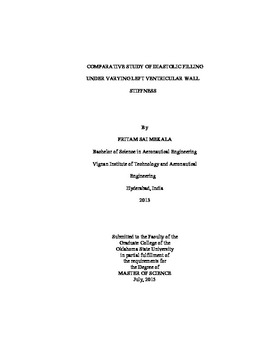| dc.contributor.advisor | Santhanakrishnan, Arvind | |
| dc.contributor.author | Mekala, Pritam Sai | |
| dc.date.accessioned | 2016-09-29T18:41:23Z | |
| dc.date.available | 2016-09-29T18:41:23Z | |
| dc.date.issued | 2015-07-01 | |
| dc.identifier.uri | https://hdl.handle.net/11244/45282 | |
| dc.description.abstract | Heart failure with preserved ejection fraction (HFpEF) is a clinical syndrome that is prevalent in over 50% of heart failure patients. Myocardial stiffening occurs in HFpEF patients prior to chronic maladaptive changes in overall chamber morphology, resulting in increased left ventricle (LV) wall stiffness. The goal of this study was to investigate the changes in intraventricular filling fluid dynamics inside a physical model of the LV as a function of wall stiffness and the presence of A-wave. The entire experiment was divided into 2 cases, inclusion of the A-wave and absence of A-wave during which three LV physical models of varying wall stiffness were compared. Physical model was incorporated into an in vitro flow circuit driven by a programmable piston pump. Windkessel elements were used to adjust the inflow and systemic pressure of the baseline LV model with lowest stiffness to match normal physiological conditions. The remaining two physical models with stiffer walls were comparatively tested without changing the in vitro circuit compliance, resistance and pump amplitude. 2D phase-locked particle image velocimetry (PIV) measurements along the central plane of the LV showed reductions in kinetic energy of the flow field, filling vortex ring circulation and inflow propagation toward the LV apex with increasing stiffness. For idealized mitral inflow profile without atrial systole, hemodynamic characteristics including the peak filling velocity magnitude, cardiac output, stroke volume, and diastolic duration decreased with increasing wall stiffness. The same trends in hemodynamics were also observed with inclusion of atrial systole to the mitral inflow profile. Further, inclusion of atrial systole to the mitral inflow showed an increase in E/A (mitral inflow velocity peaks) ratio from 1.2 for the baseline (least stiff) LV model to 2.2 for the stiffest model, suggesting restrictive filling occurred in the latter. The results of the study show the adverse hemodynamic impact of pathological alterations in wall stiffness even when gross LV morphology is unchanged. The circulation strength of the intraventricular filling vortex can be potentially used as a fluid dynamic marker for improving diagnosis of HFpEF. | |
| dc.format | application/pdf | |
| dc.language | en_US | |
| dc.rights | Copyright is held by the author who has granted the Oklahoma State University Library the non-exclusive right to share this material in its institutional repository. Contact Digital Library Services at lib-dls@okstate.edu or 405-744-9161 for the permission policy on the use, reproduction or distribution of this material. | |
| dc.title | Comparative Study of Diastolic Filling under Varying Left Ventricular Wall Stiffness | |
| dc.type | text | |
| dc.contributor.committeeMember | Elbing, Brian R. | |
| dc.contributor.committeeMember | Sallam, Khaled A. | |
| osu.filename | Mekala_okstate_0664M_14118.pdf | |
| osu.accesstype | Open Access | |
| dc.description.department | Mechanical & Aerospace Engineering | |
| dc.type.genre | Thesis | |
